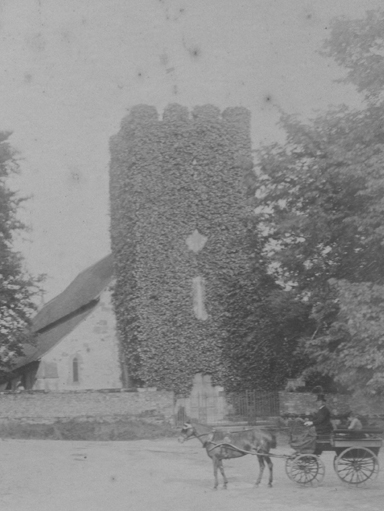The tower is now a plain structure with a clock facing west. The original tower, with four bells, was destroyed by a fire caused by lightening in 1712. The Churchwarden’s book records: “Monday morning between 4 and 5 of the clock, the 17th day of November anno 1712, Berriton Steeple, being shingled and about 80 foot high, took fire by a very terrible tempest of thunder and lightening nigh the top and was burn’d down.” It was rebuilt, and five new bells hung, in 1715. All of the bells have been re-cast and re-hung since then and a sixth bell was donated by Mrs Seward of Weston in 1935 in memory of her daughter.
A former clock, with a face high up on the north side of the tower, was put up in 1717 at a cost of £20. The position of this former clock is still outlined in the stonework and would have shown the time to the Manor House and to the farm labourers.
Inside the tower, on the wall of the ringing chamber, is inscribed a ‘Ringers Rule’:
Advice to ringers and to such
That delight in bells and love ye Church
Beware of oaths and quarrelings
Take heed of clams and janglings
There is no musik played or sung
Like unto bells if they are well rung
Do you keep silence and forebear
Of smoking of tobacco here
If you your bell doth overthrow
It is your fourpence before you go
If you ring in hat or spurs
Be sure you pay, make no demurs.
The church was closed for a year in 1877-78 for extensive restorations which included a new roof, repairs to Nave arches and new screens and seating. During this time, the school was used as a church although at least one marriage took place “in the church without a roof”.
St. Mary’s is large for a village Church, having been the mother Church for a parish of 6,000 acres including Petersfield and Sheet. It was not until 1886 that Petersfield with Sheet became a separate parish.
A church orchestra, in a musician’s gallery at the west end, was succeeded by a barrel organ until 1897 when the pipe organ was given by Mrs Bennion. Central heating was presented by Mr Bennion in 1896 replacing a stove which had stood at the rear of the church in the west end of the nave. It is said that the men took up all the back seats at this time! Electric lighting was installed in 1938, replacing 19 oil lamps which were used in winter and candles which were used in the summer.
From certain angles the church appears as though it is crouching and this may be due to the fact that the surrounding ground, the churchyard, has risen by about 2 feet 6 inches – having been the resting ground for local people for close on 1,000 years. Records show that in 1830 the ground was moved from the walls of the Church down to the inside level and brick gutters were laid. This shows quite vividly how much the ground has risen through the years.
In 1994 the 800 year old church received its first addition since the south porch was built in 1860. A meeting room, with a small kitchen and toilet facilities, was built onto the north side of the church to provide a valuable family and social area to complement the main function of the building. But the project was not without its excitement. Everyone knew that no burials occur on the north side of Christian churches. Nevertheless, just to be doubly sure (and just before the construction contract was due to be signed), archaeologists were invited to dig a trench. The site turned out to be full of interments, dating back to medieval times. For a while it looked as though the project might be lost at the eleventh hour but, by raising the extension by half a metre, the architects were able to minimise disturbance to the graves. Which explains why there are steps up into the Seward Room …




